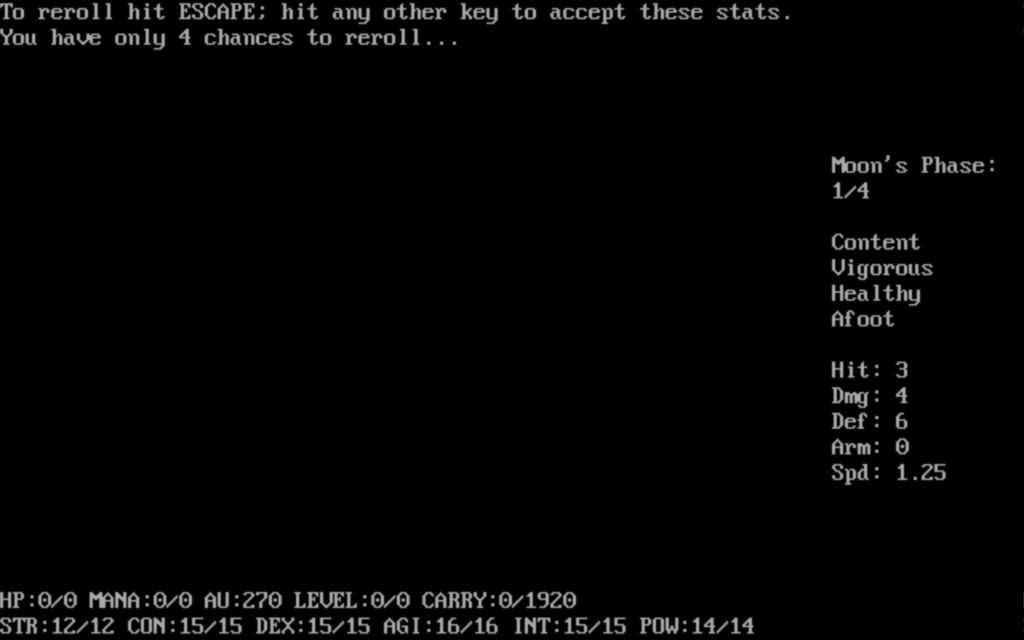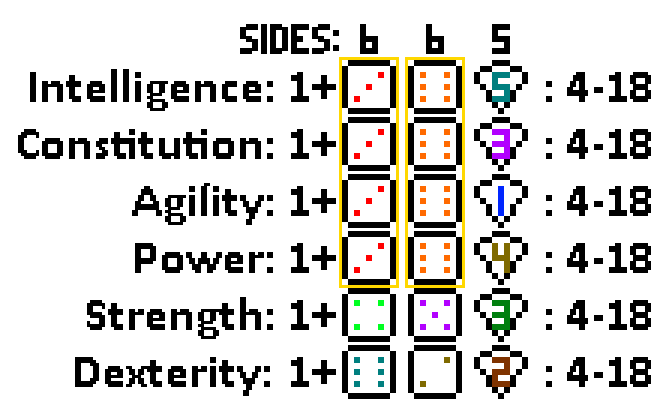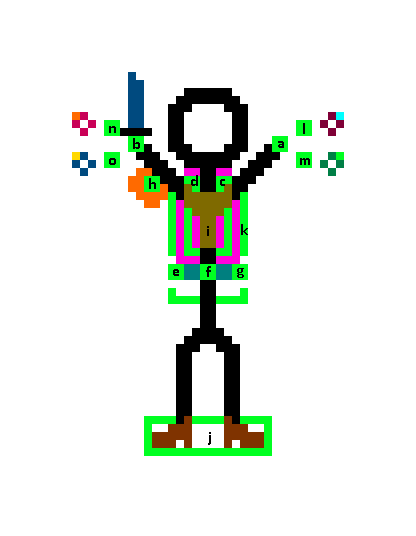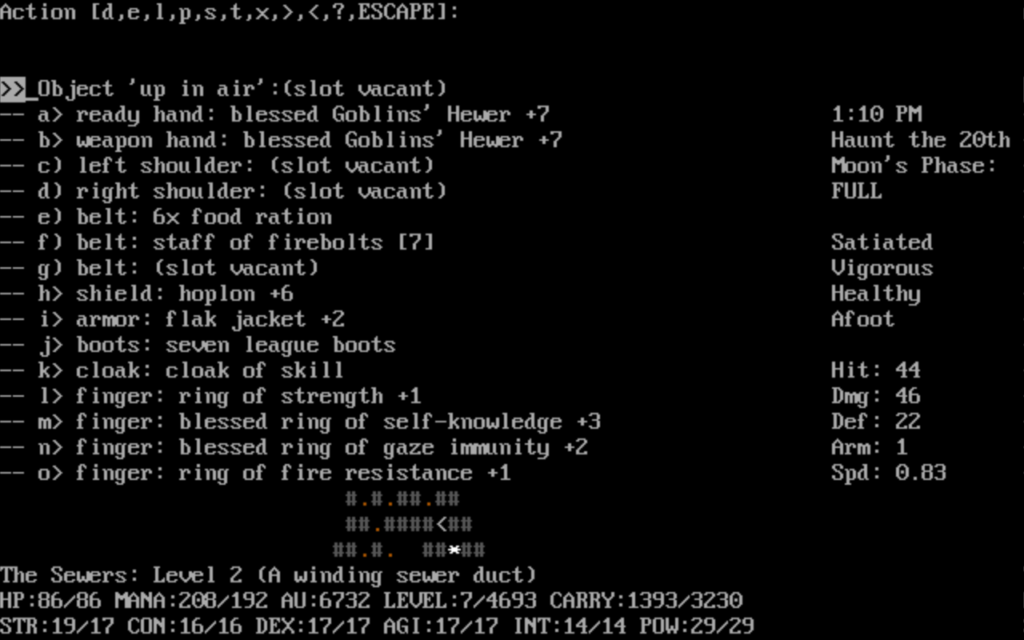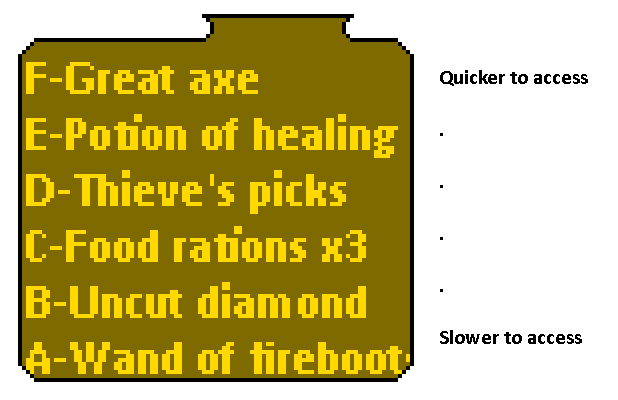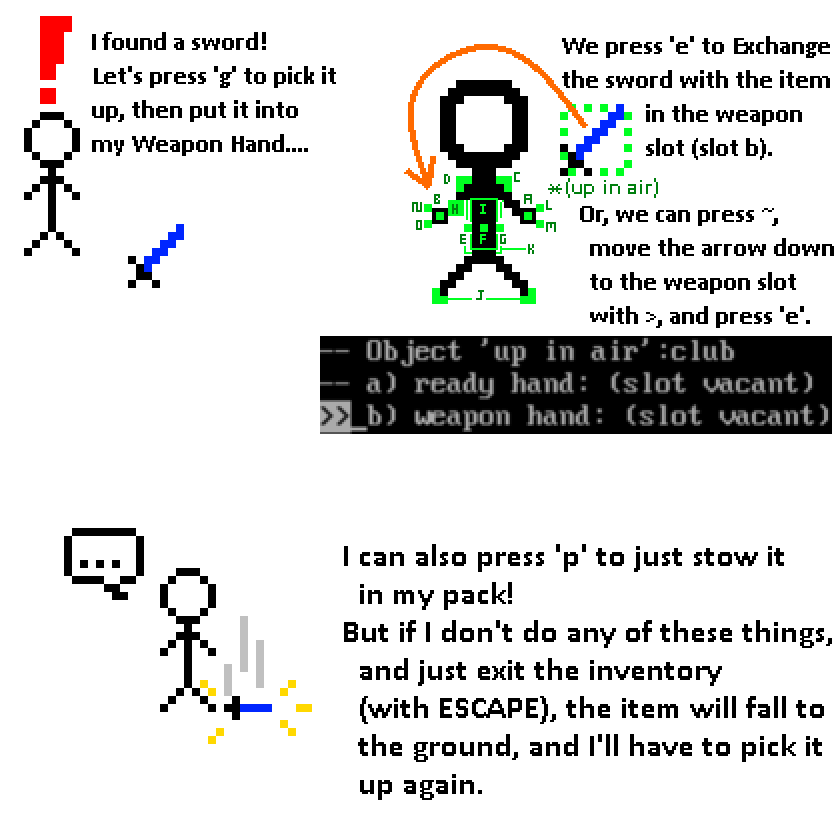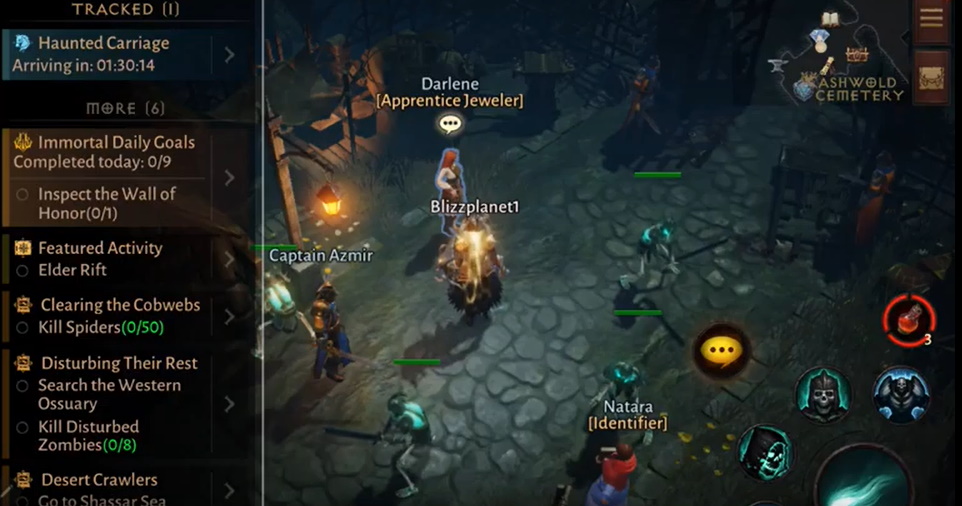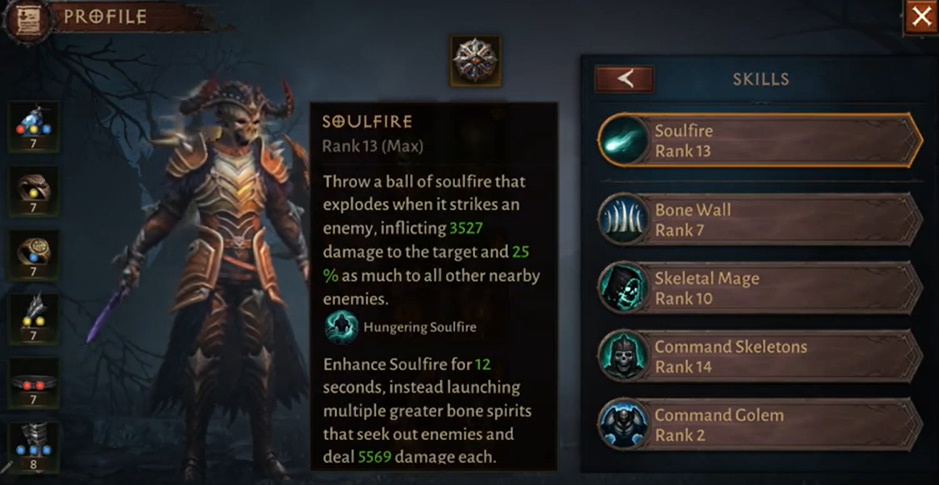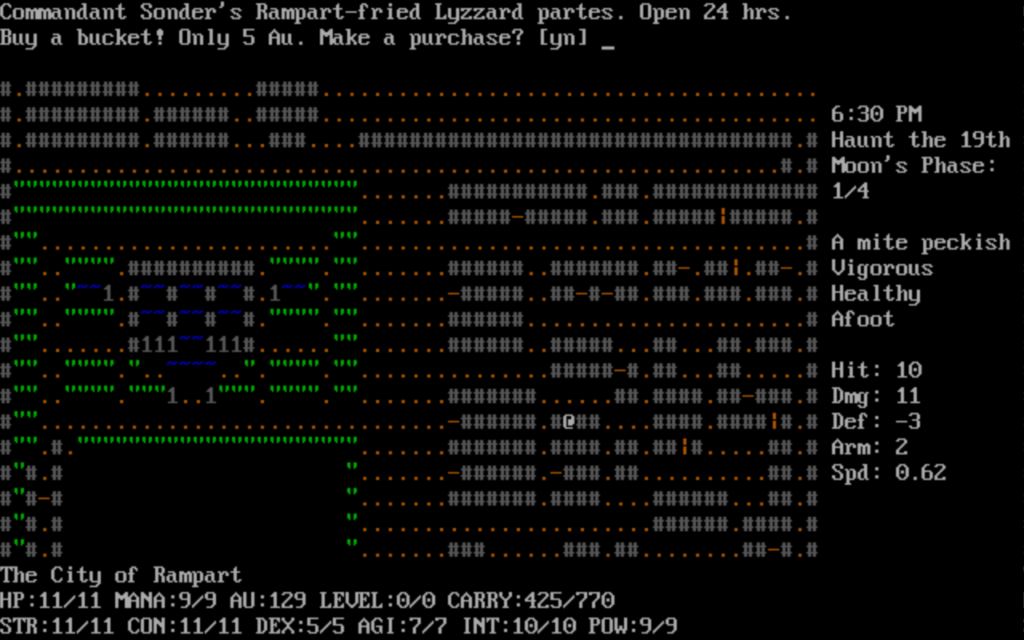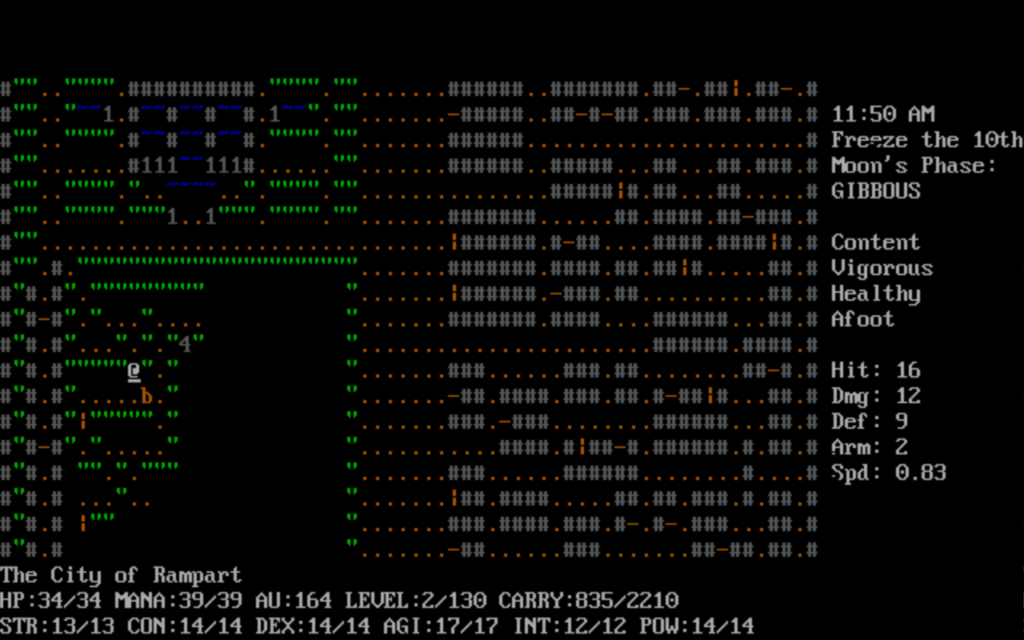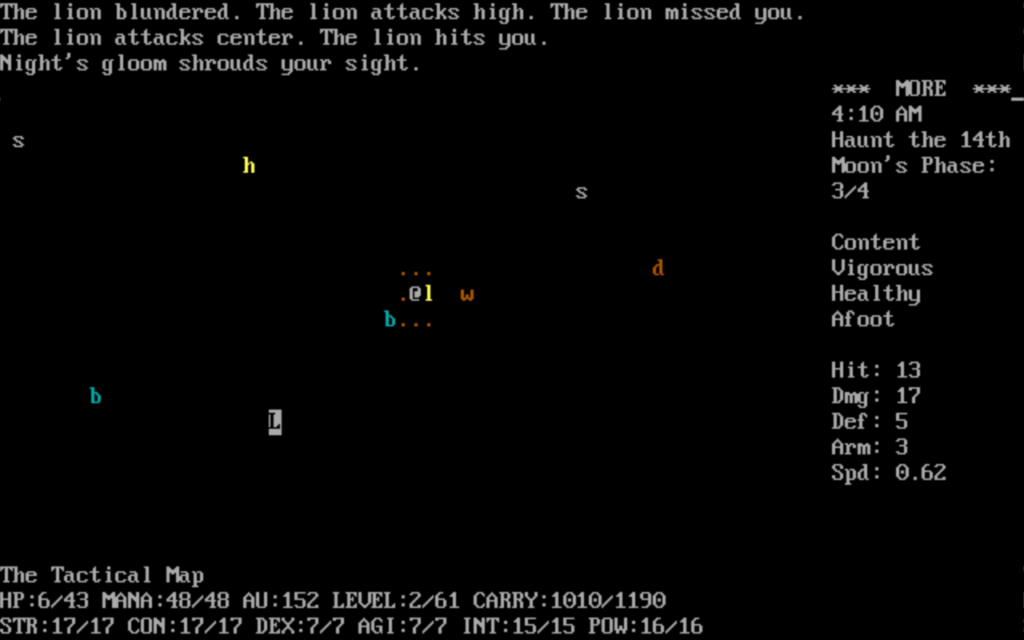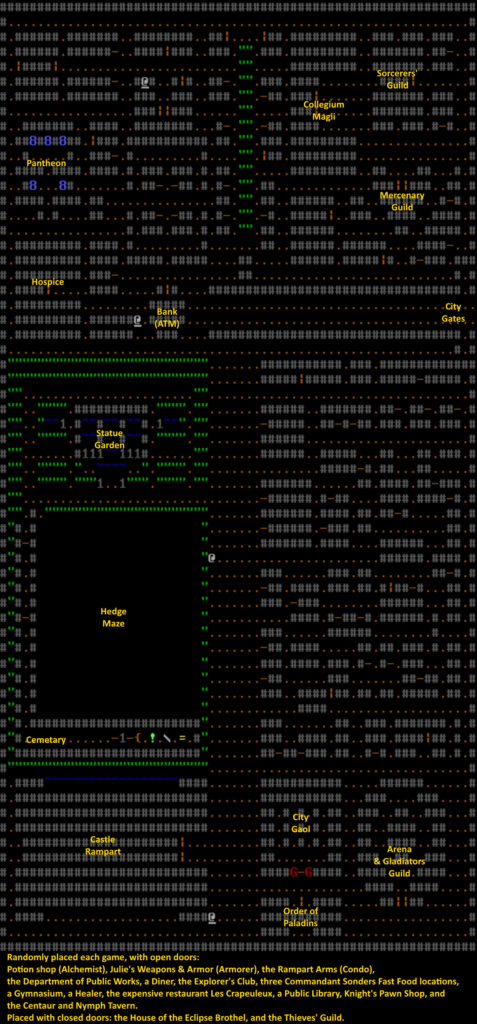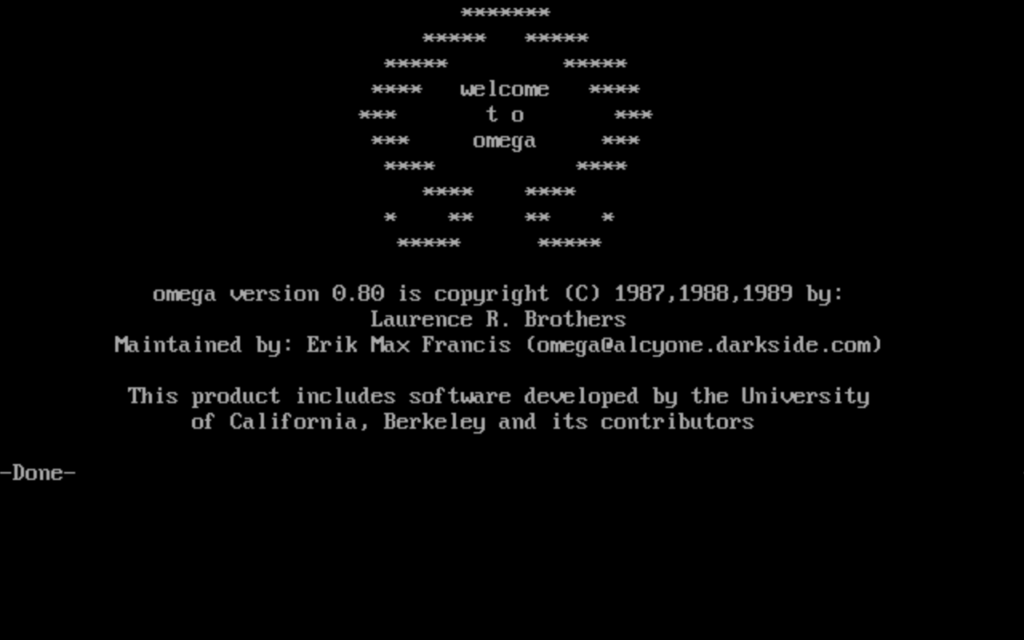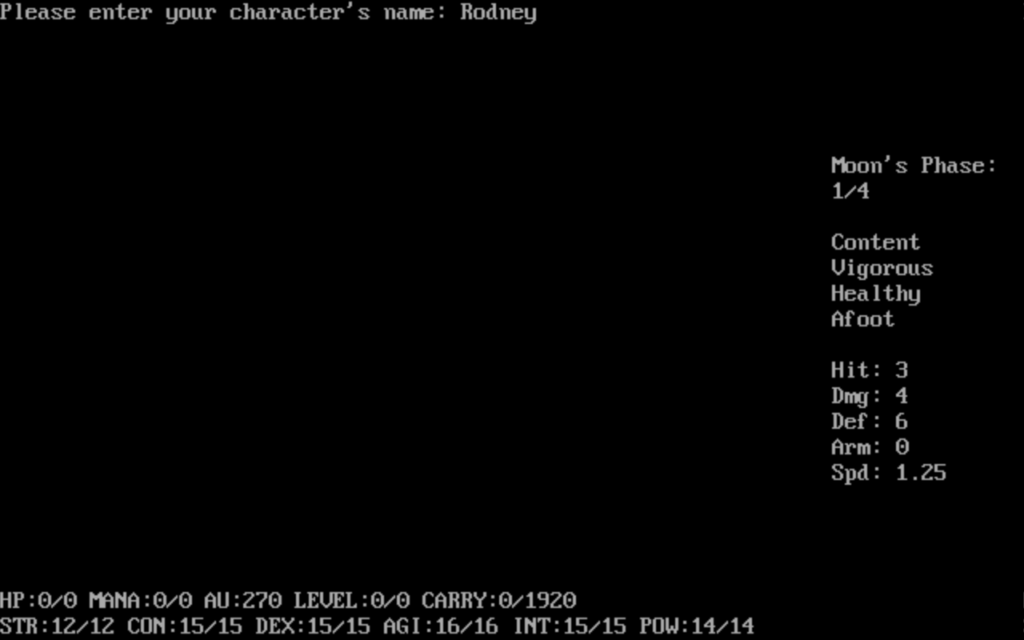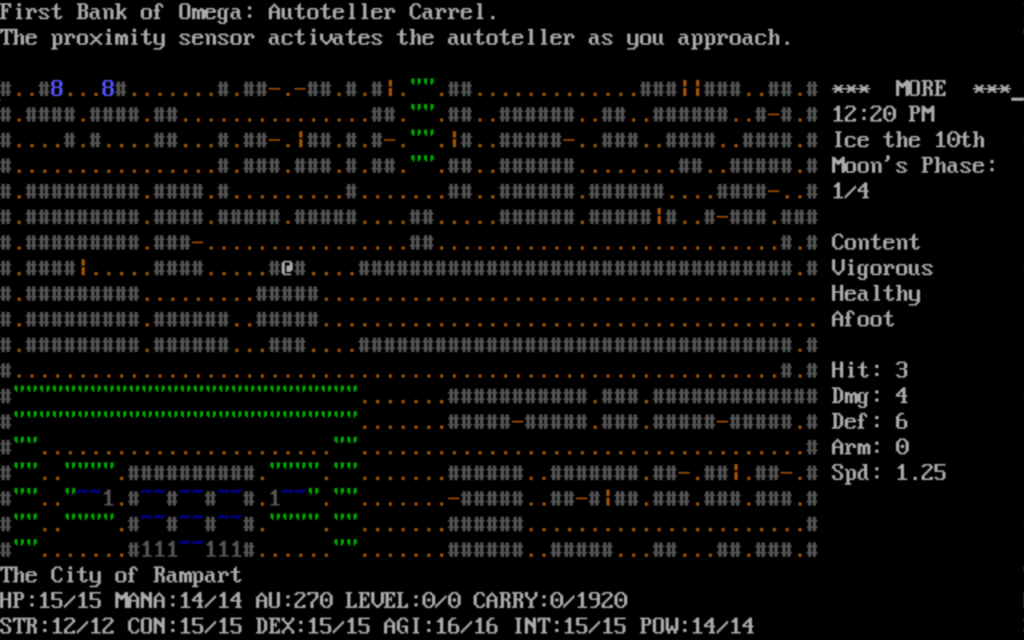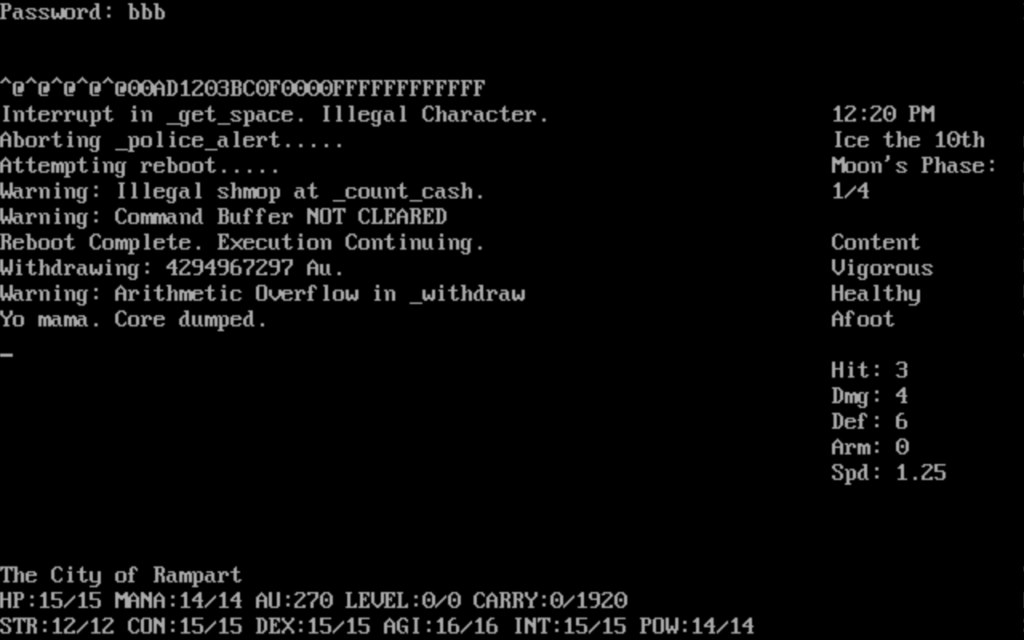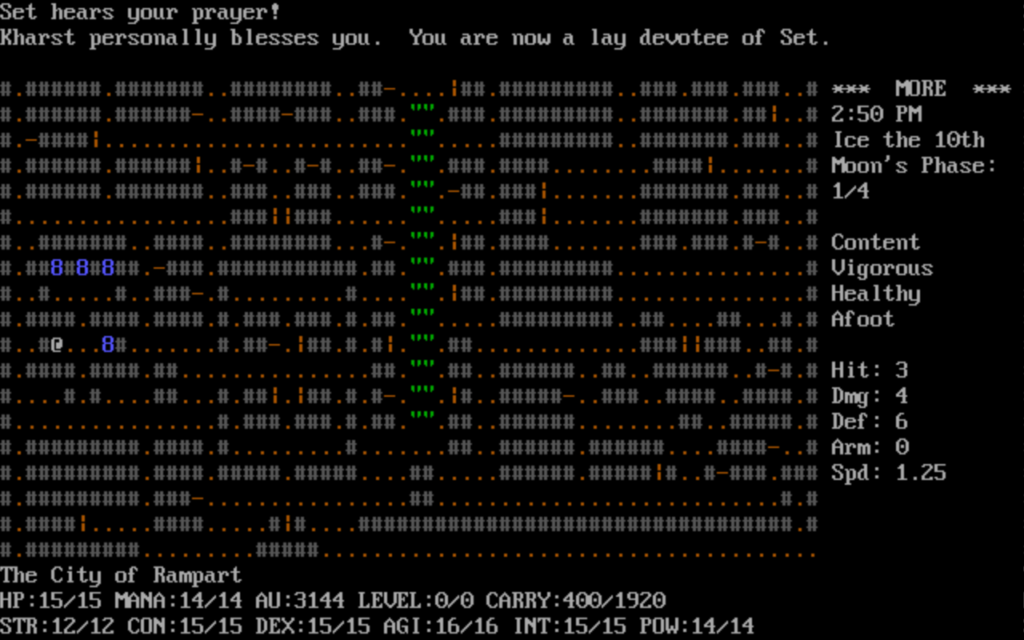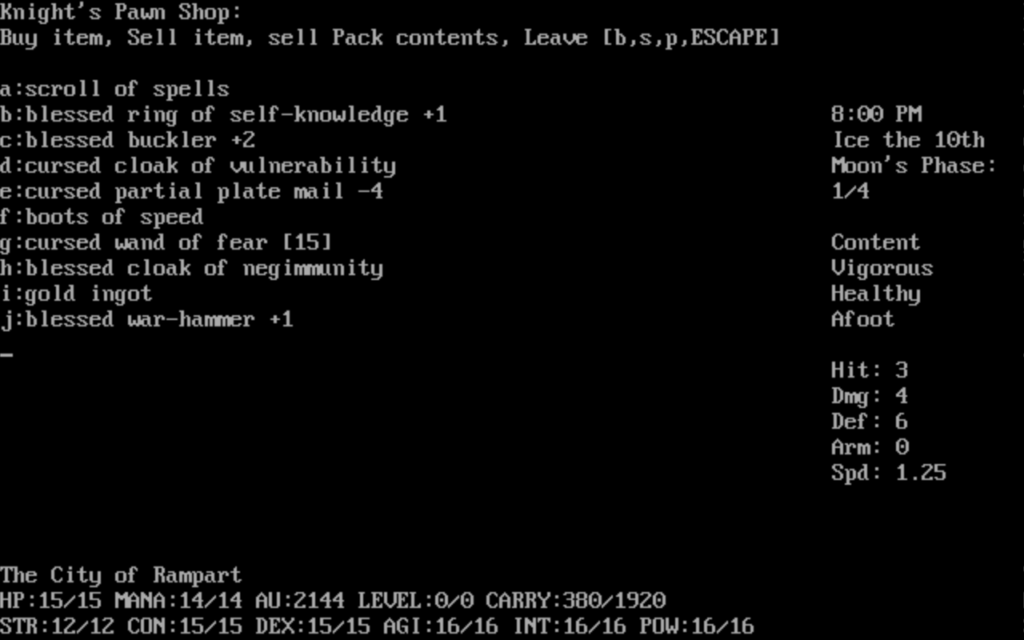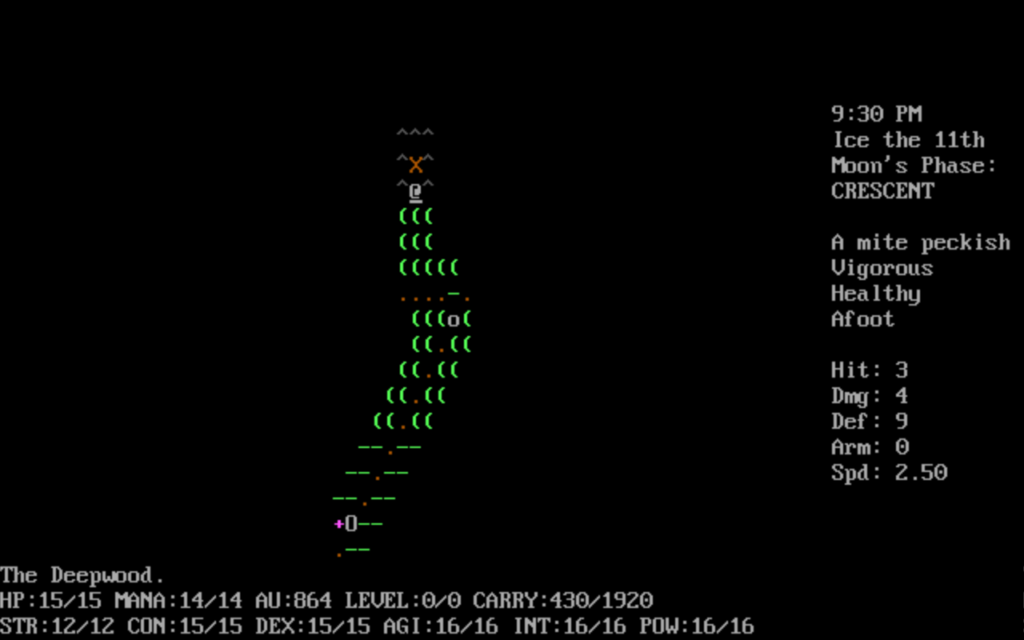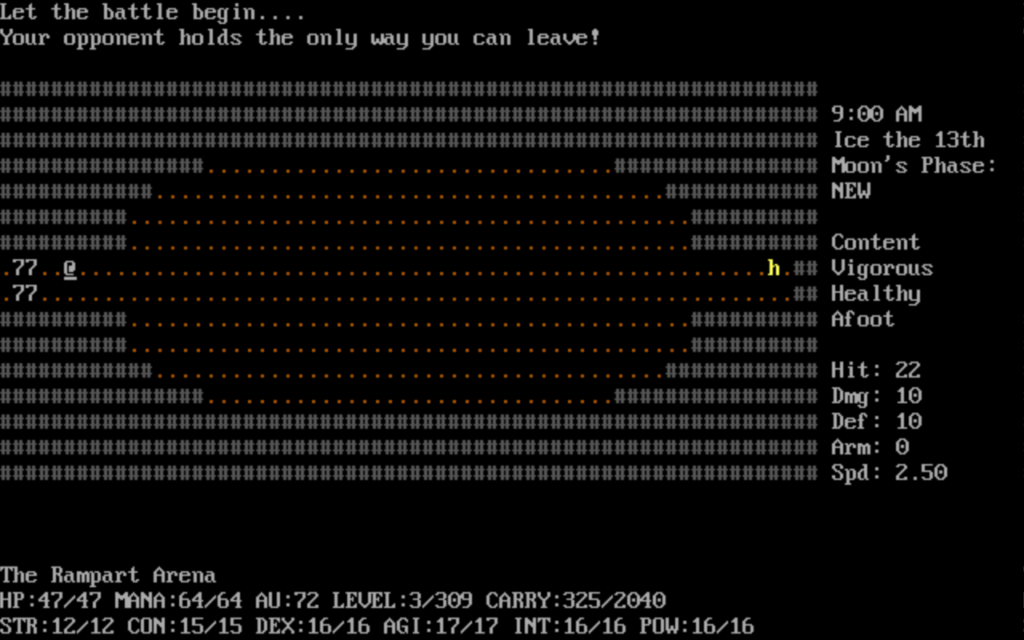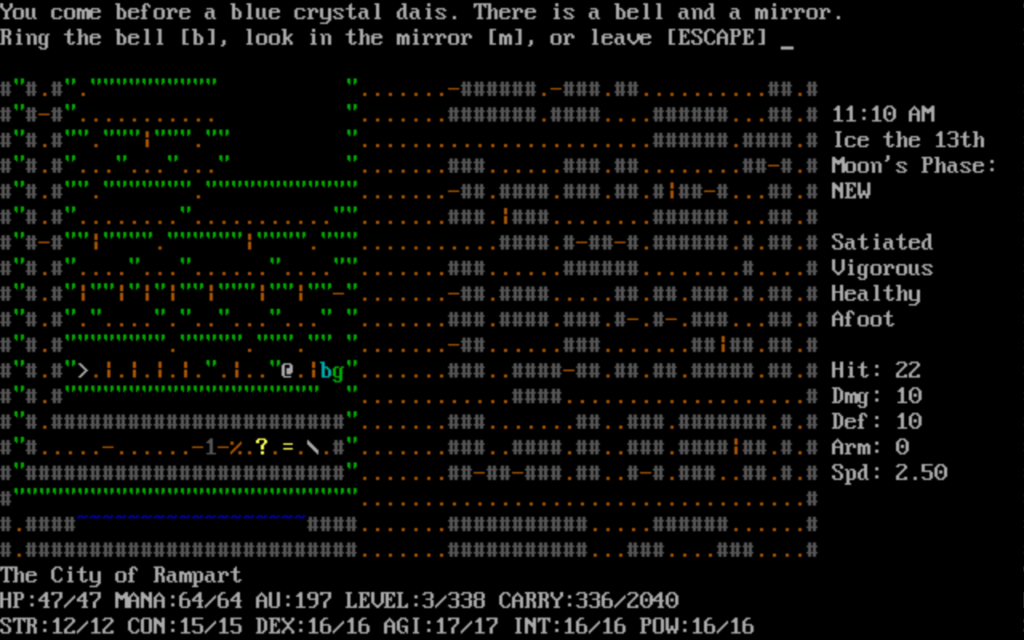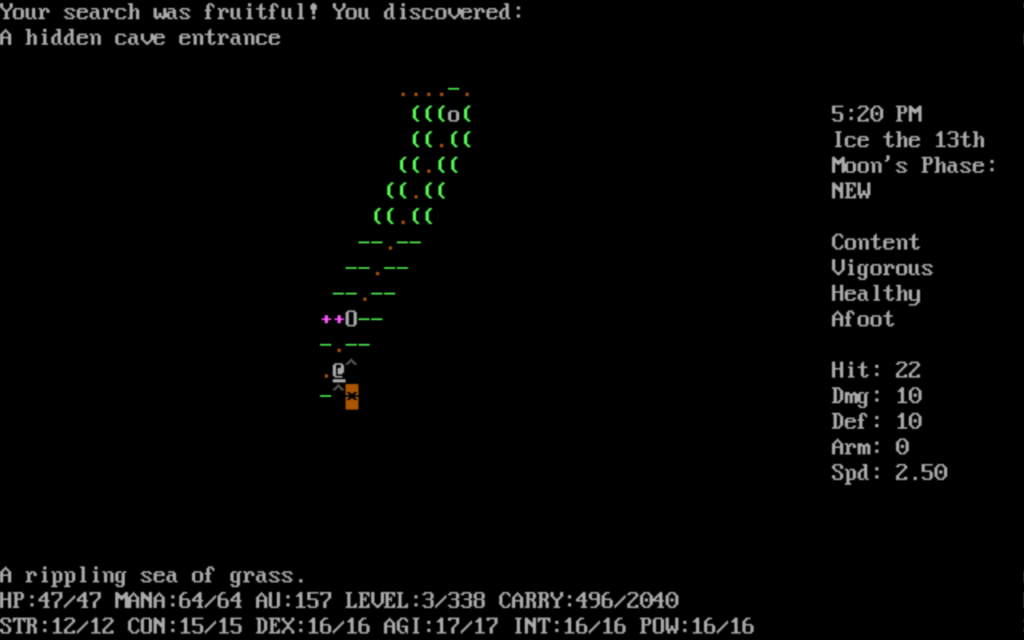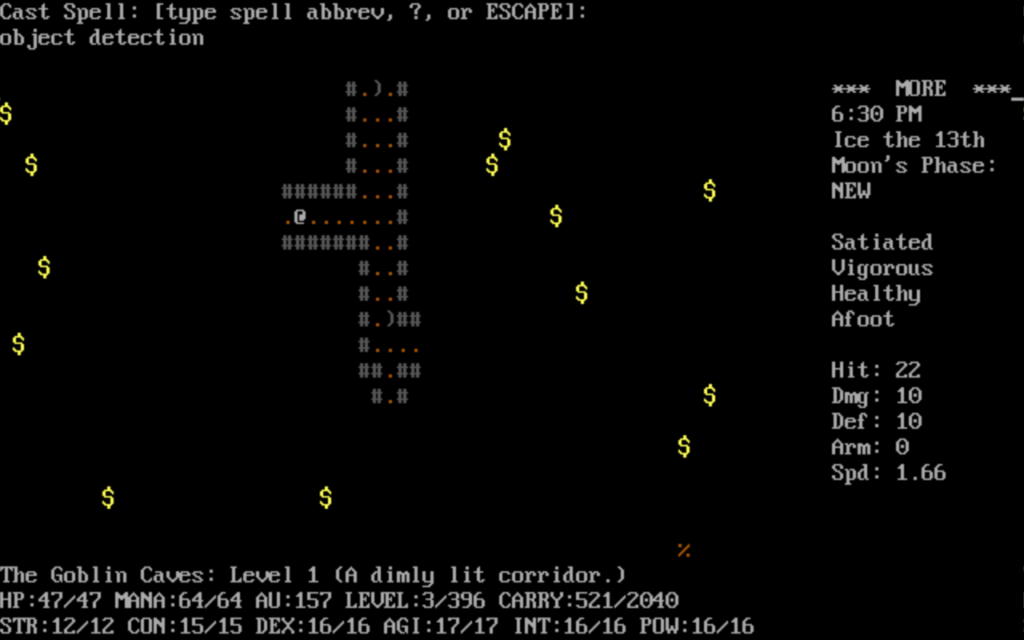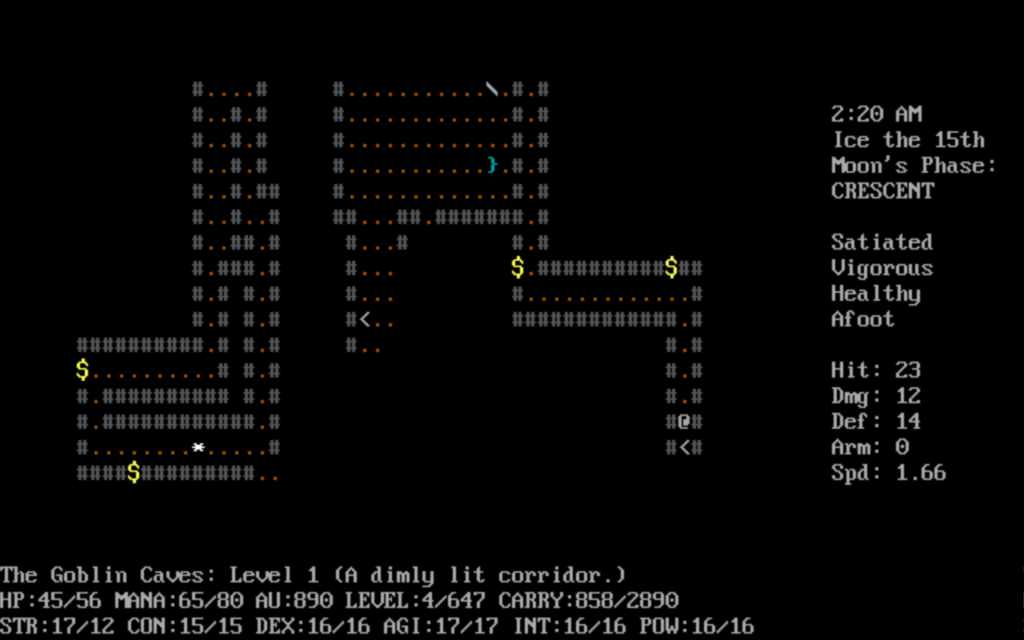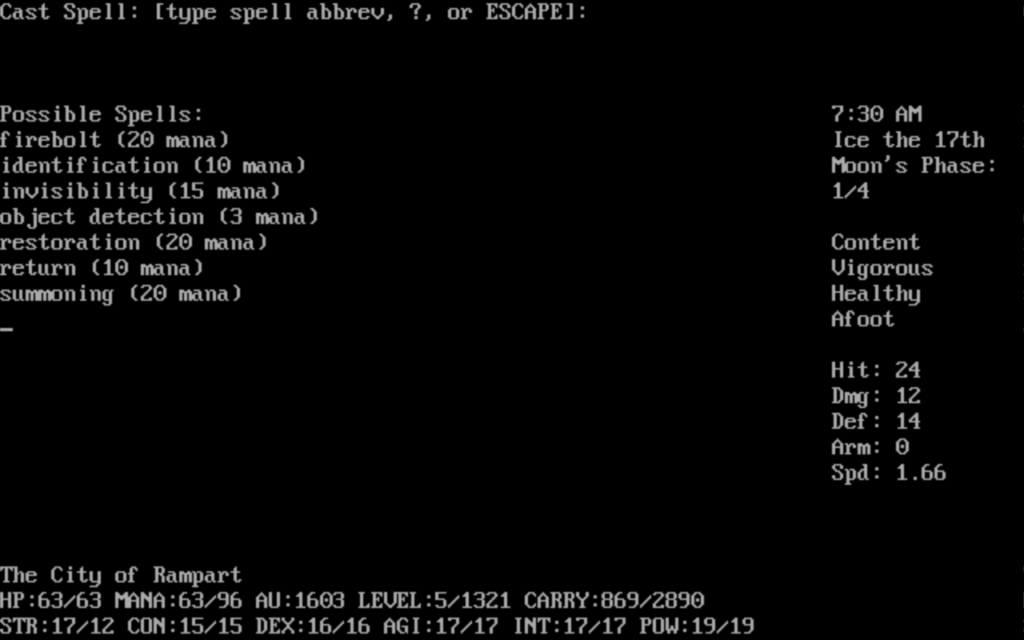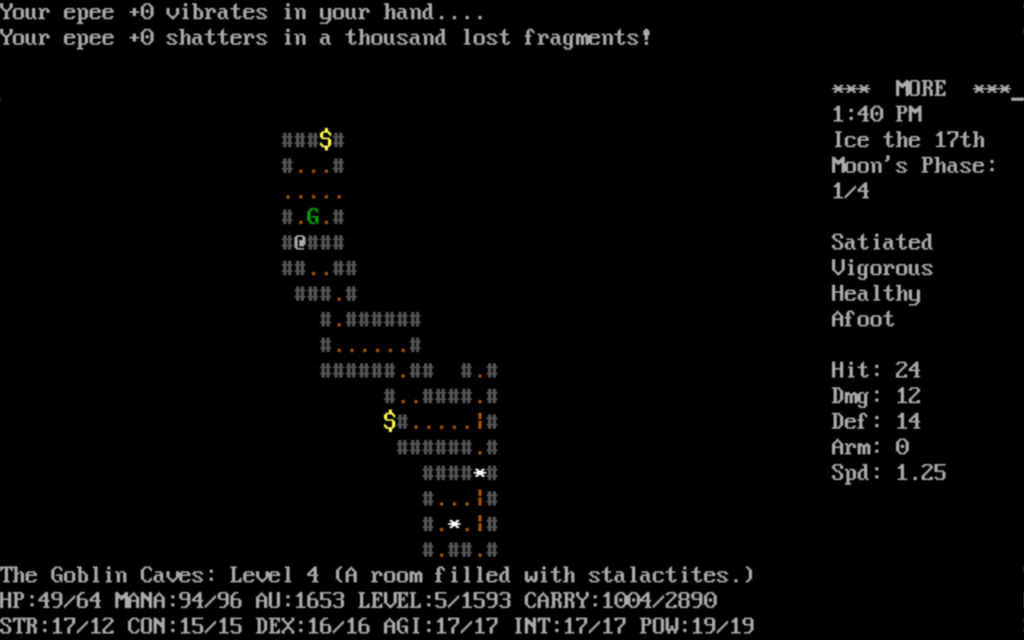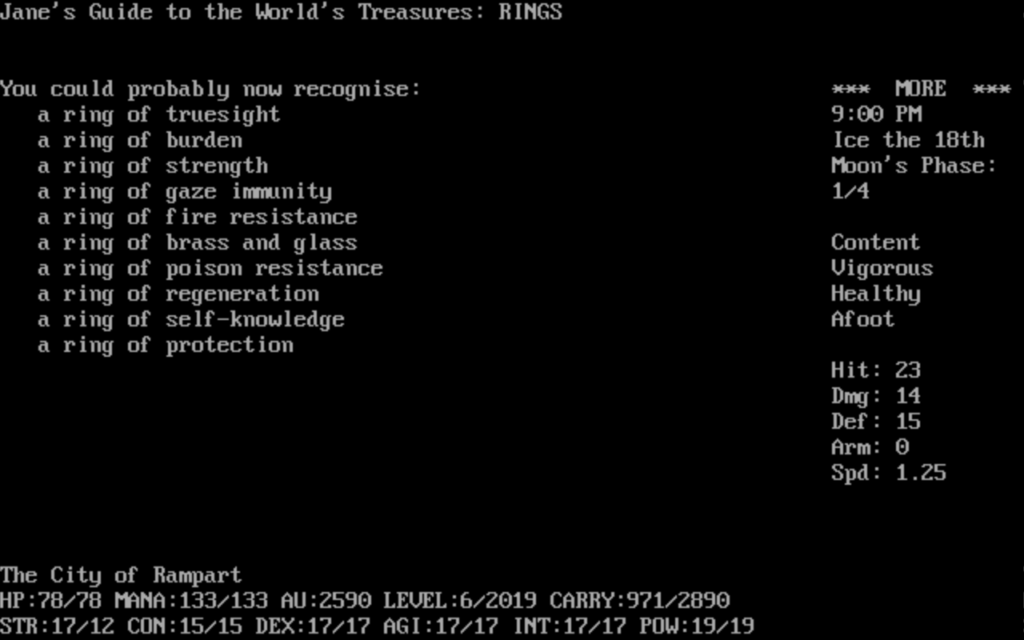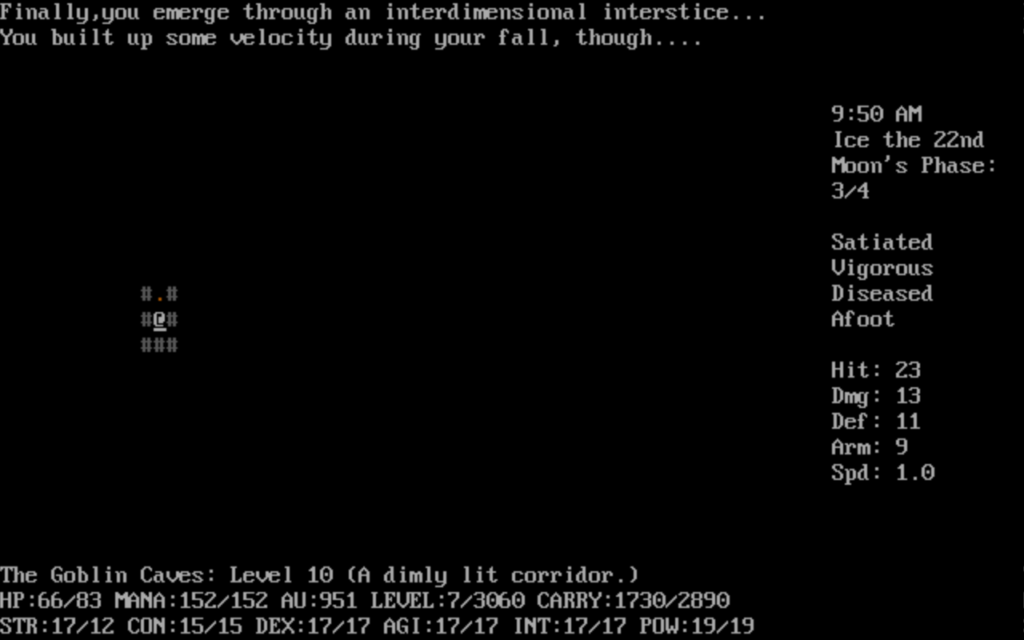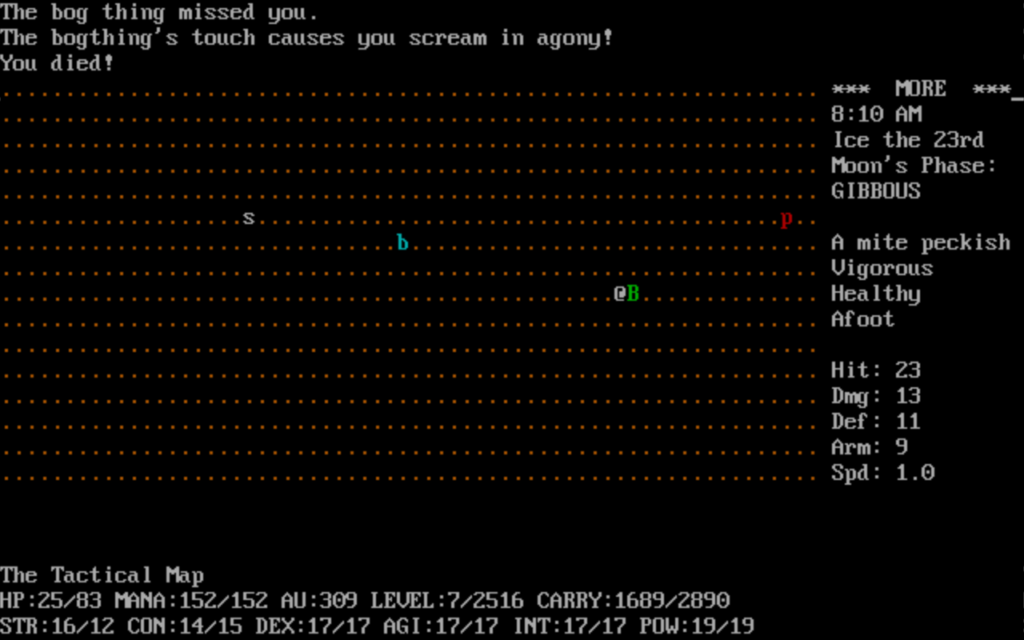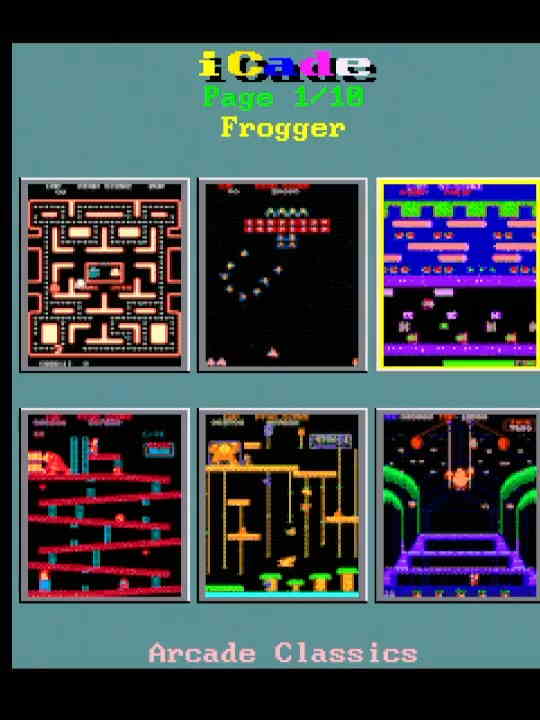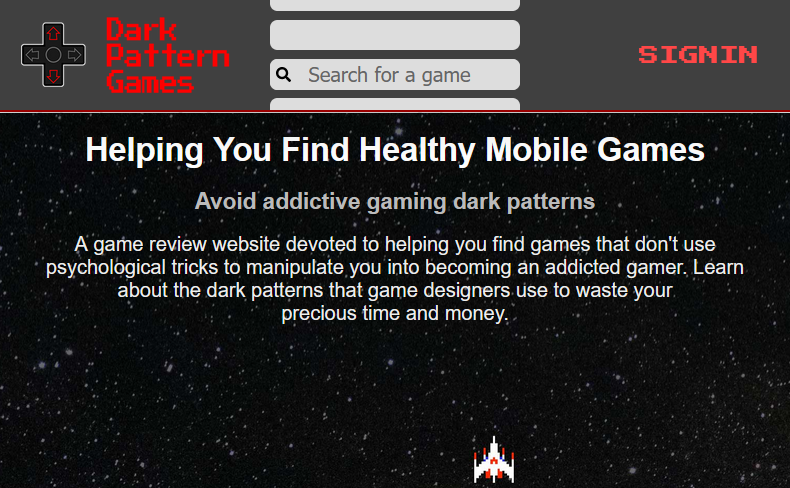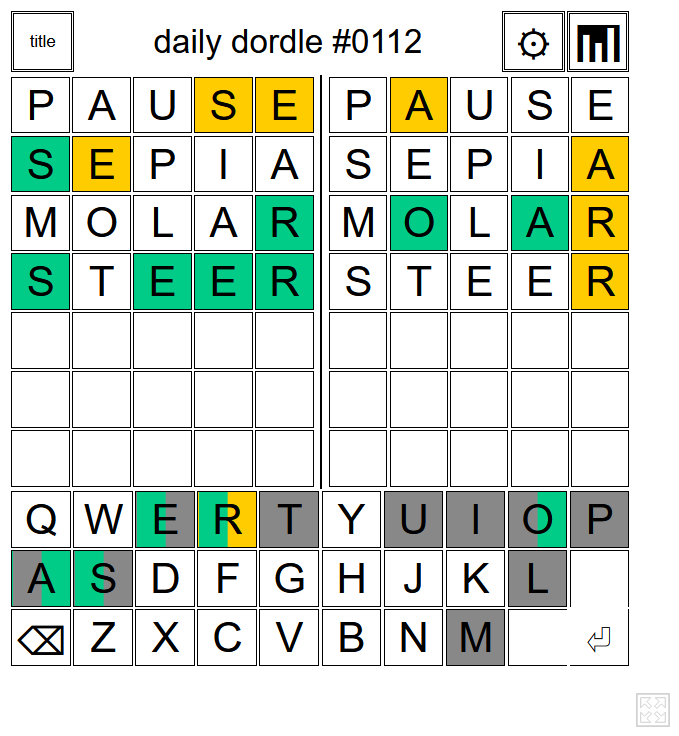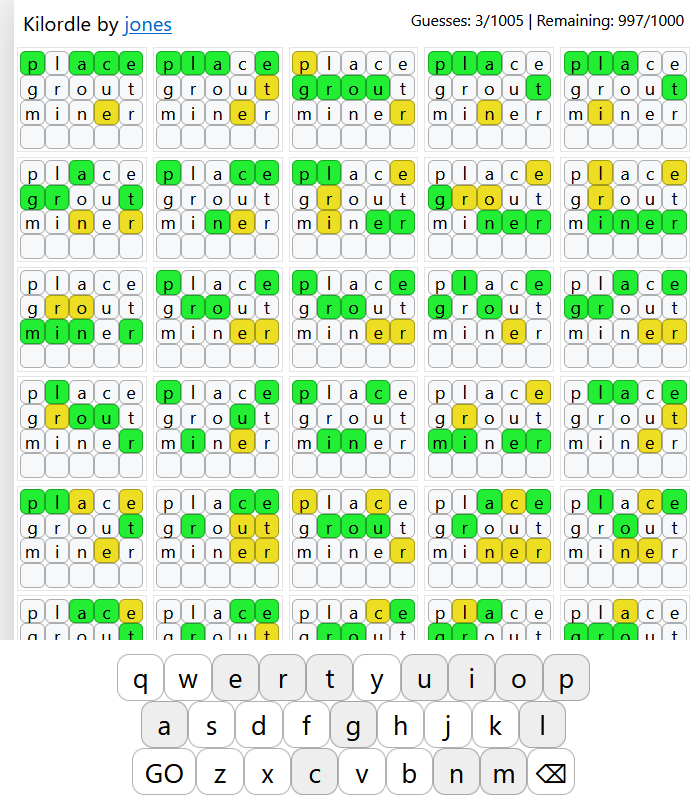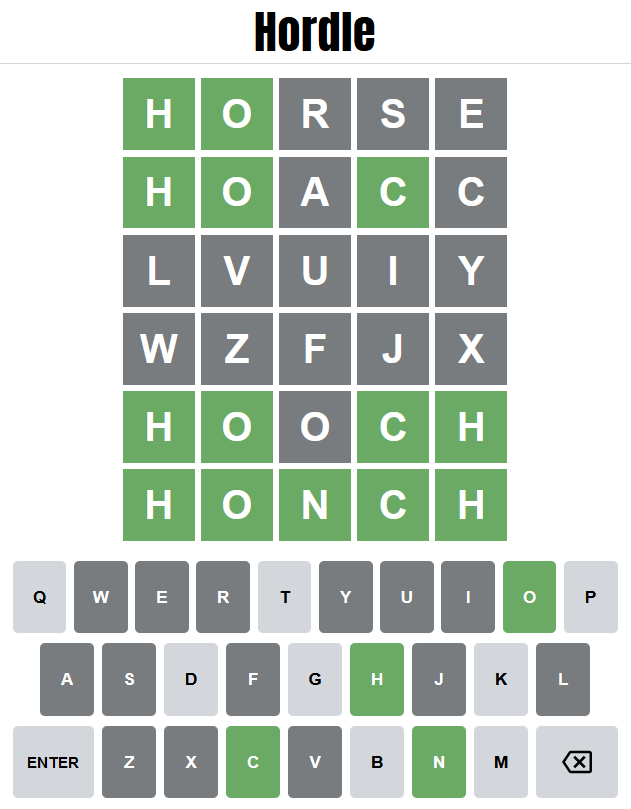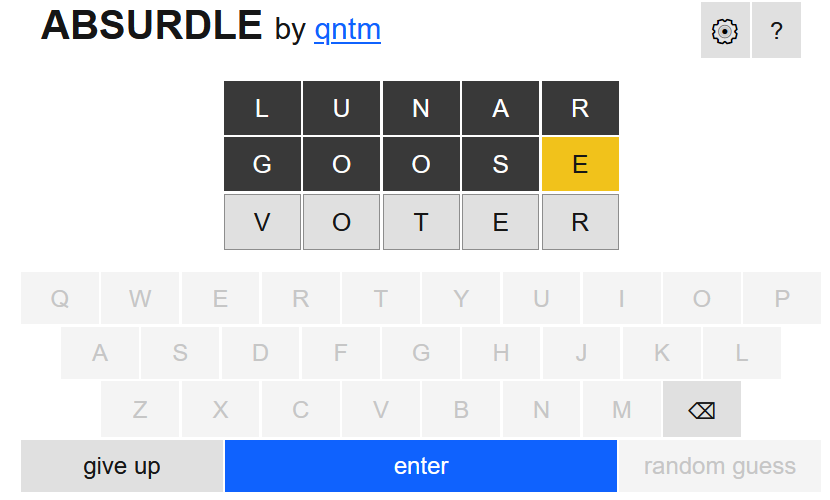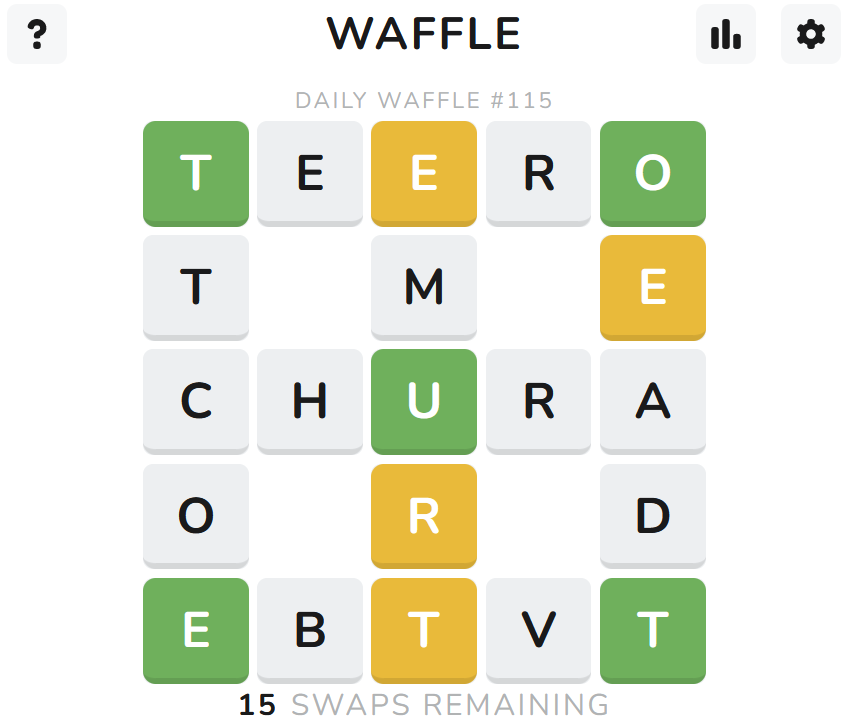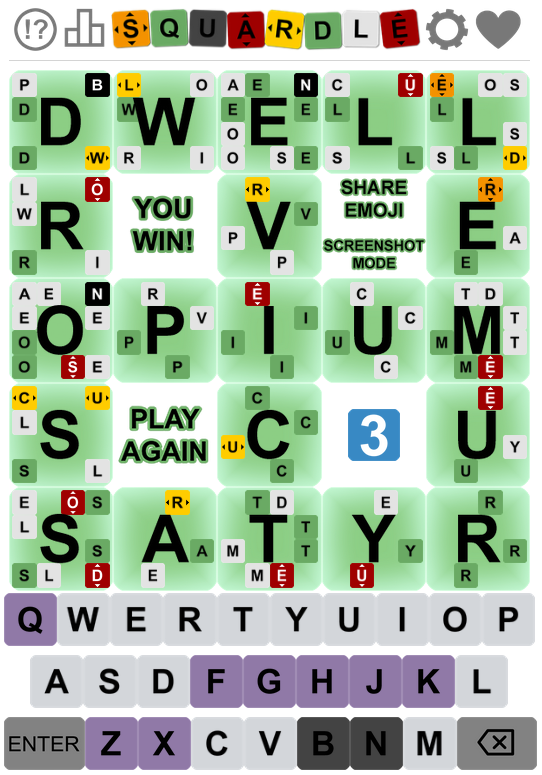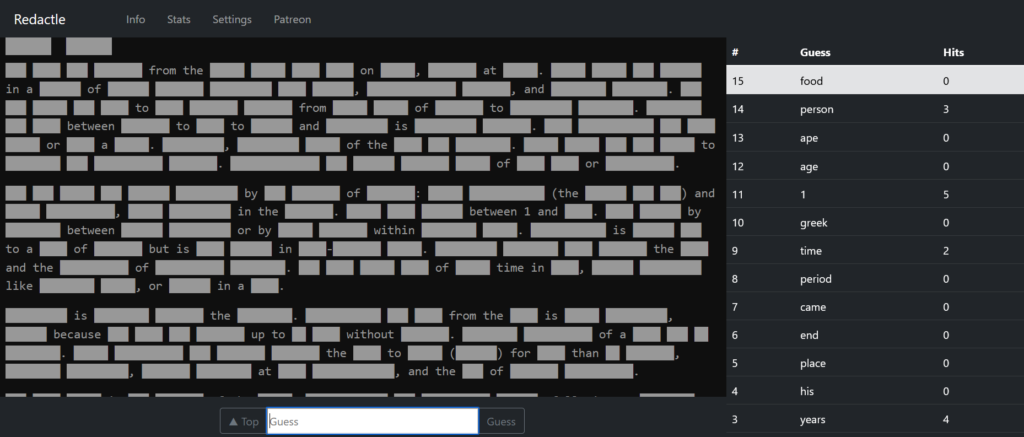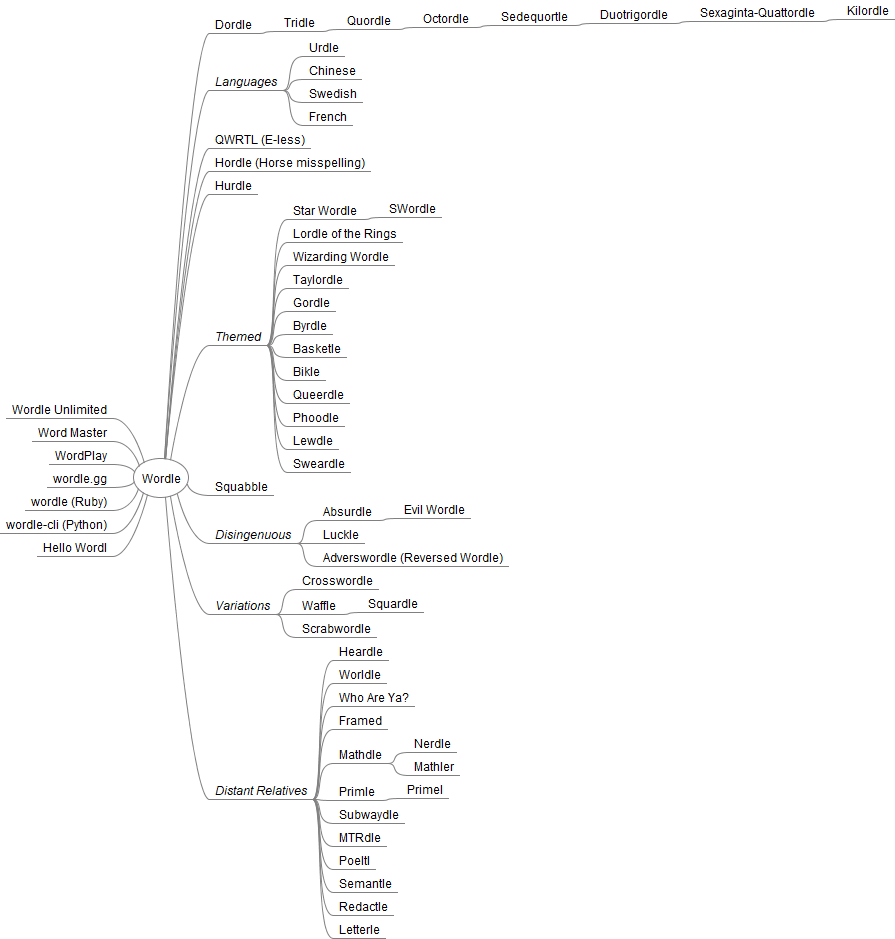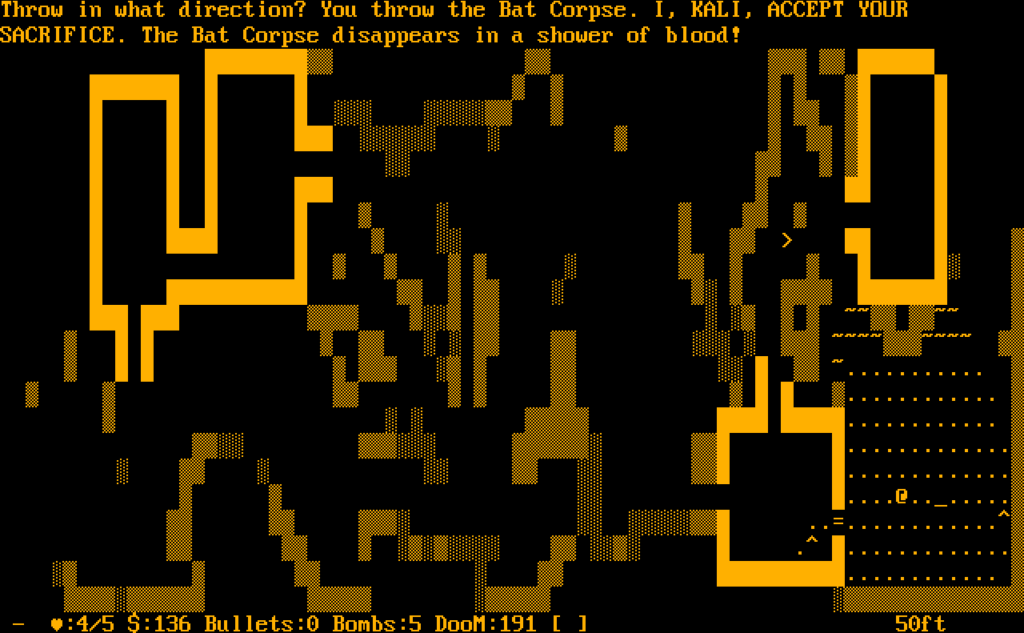
‘@Play‘ is a frequently-appearing column which discusses the history, present, and future of the roguelike dungeon exploring genre.
So let us talk about what is probably the worst thing about Omega: it’s capriciousness.
If you read the experiences of the CRPG Addict you might be given to thinking that Omega is actually pretty easy. Judging by the title screen on his review, he was playing 0.71, a version I don’t have access too, and may actually no longer be available anywhere on the vast World Wide Web.
My version is 0.80, which it seems like it must be harder than his. Also, he backed up his save games, which, while the instructions specifically suggest it if you’re having trouble, is still cheating. All of my games have been played traditionally. And let’s be clear as to why: because I’m a snob. A roguelike snob.
Of course most classic roguelikes have a degree of deadly capriciousness, but for some reason it’s especially bad in Omega. I don’t think I’ve seen a game with as many ways for a game to go from terrific to dead instantly, often without warning and in a single turn.
Here’s a list of ways this can happen, most of which I’ve personally seen.
- To get it out of the way: you can be struck by a cosmic at nearly any time above-ground (and even underground? I don’t think so). That does 10 damage purely from random chance, with no way to avoid or reduce it. If you have less than 10 HP, your game is just over. Some characters don’t even start with 10 maximum HP.
Cosmic rays are triggered at two different places in the code, on tables for indoor events and outdoor events. My reading of the code indicates that indoors, a check that can produce a cosmic ray happens every ten game minutes, and outdoors it’s every game hour. However, depending on the terrain, multiple hourly checks can be made per move. Cosmic ray hits are far from the only bad things that can happen per hour, so it’s best to go by road if you can, and with other travel aids if possible. - The hedge maze in Rampart is a terrific source of deaths. Traps in there can absolutely wipe you out, or else make the game unplayable. Traps exist elsewhere, but the hedge maze both has a higher density than elsewhere (it always seems to have at least one, and probably has several), and is right there in Rampart. There are a small number of possible layouts for the maze, and traps tend to appear in the same kinds of places, so eventually you figure out where you should search. Specifically: fire traps and scythe traps do a lot of damage, an abyss trap can bestow a bunch of falling damage arbitrarily and effectively teleport you, acid traps do damage can destroy multiple pieces of equipment, a disintegration trap can destroy equipment or kill you outright, and an alarm trap won’t do any damage, but it will make all the guards in Rampart permanently hostile, dooming your character unless you can take them, which is unlikely at the point in the game when you’ll be exploring the hedge maze.
- Once you step out of the starting city of Rampart there’s the countryside, a whimsically deadly region where you can have “encounters,” during which you may be killed (I can attest) by bandits, goblin shamans, lions, bears, bog haunts, mirrorshades, liches, or even “doberman death-hounds,” who are both fast and get lots of attacks.
Encounters can generate a monster right beside you, and in that case the game even gives it the first turn. Many times my games have consisted of spending the 15 minutes or so getting all my chores in Rampart done to get my character started, leaving town, getting an encounter on the way to the Archdruid’s temple, and getting wiped out literally before I could do anything. The only thing you really can do about these situations is decrease the amount of time you spend outside.
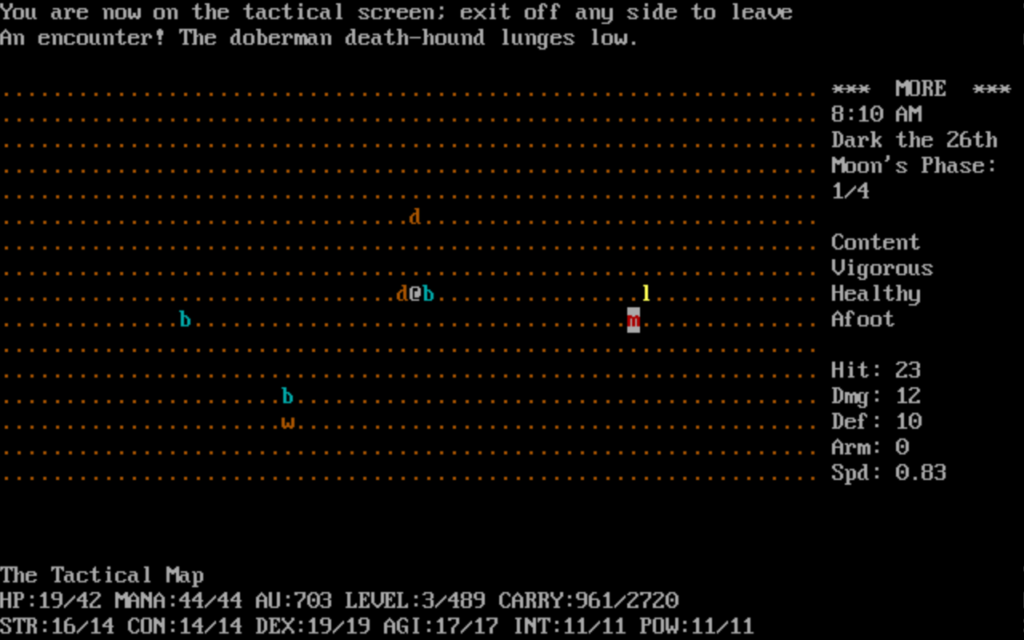
I’ve died to random encounters three games in a row before:
#1: Upon exiting the Archdruid’s temple, immediately, a random encounter. Then, in the tactical map, they got a turn before me and I died. I don’t even know what it was; it was invisible and killed me with a missile.
#2: Upon exiting the city of Rampart, again before I got a turn, a random encounter. This time it was a goblin shaman casting spells. One was an area effect spell that killed the caster and awarded me an experience level, but then also killed me.
#3: I got some steps towards the Archdruid’s temple before I got a random encounter that completely surrounded me with hedges. Trying to wade through them poisoned me to poison death.
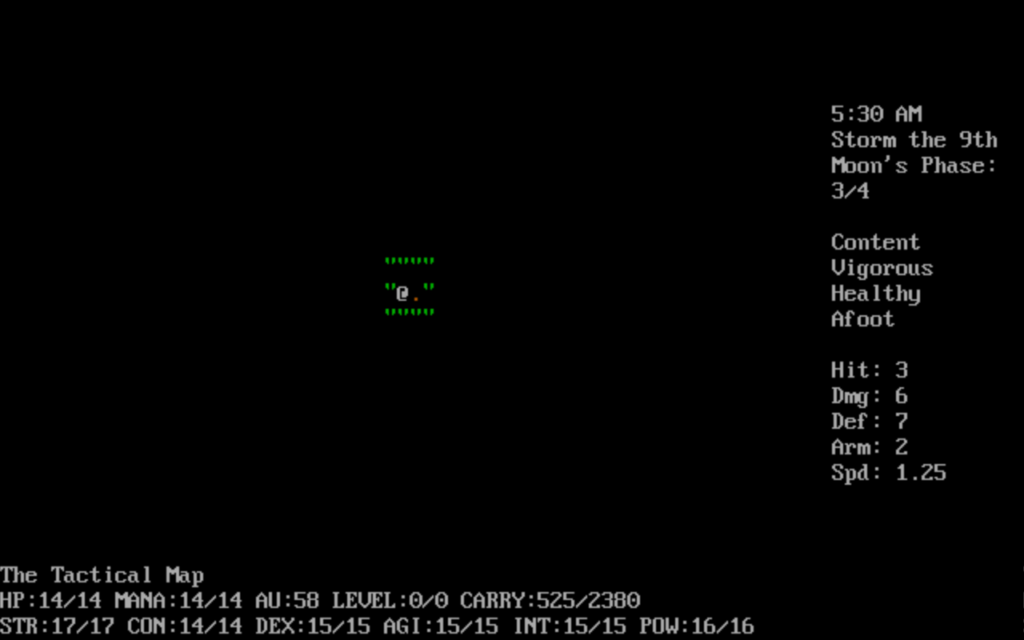
- Disintegration traps deserve special mention. I have again checked the game’s code and discovered the logic is: when you activate one, if you’re wearing a cloak, it’ll get disintegrated, no checks, no save, it’s just gone no matter what it is. If no cloak, it’s your armor that gets disintegrated. If no armor, it’s you. Traps in Omega are not common in the Goblin Caves, but can be anywhere there, and there’s lots of space for them.
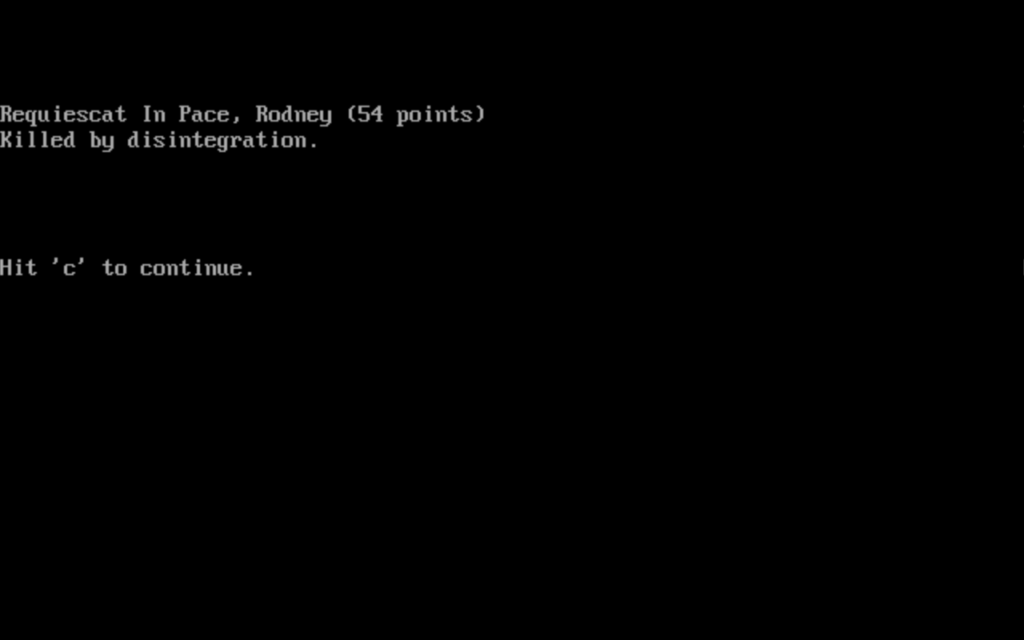
- Back to the hedge maze. Monsters can get generated there too, sometimes out-of-level ones, like lions, bears, “were-swarms,” frost demons, or pterodactyls. It’s right by the cemetery too, and sometimes it gets incorporeal visitors from there.
- The hedges themselves can easily kill you. The game always asks if you’re sure when you accidentally miskey into one, thankfully. If you answer ‘Y,’ you open yourself to be stuck to the brambles for a not-insignificant number of turns, getting poisoned (easily deadly if you’re still at level 0), have your cloak ripped apart, or, if your luck is particularly bad, walking straight into the waiting tentacles of a trifid. Moral: YOU SHOULD ANSWER ‘N.’
- Then there are the monsters who have unusually deadly attacks. Salamanders can breathe fire for high damage and from a distance unless you have fire resistance from a ring. Bog things can outright frighten you to death in melee. Until you learn that you should wear heavy armor to survive the Goblin Caves you’ll frequently get missiled to death by goblin chieftains, which are a prominent early source of fatality.
- Learn to handle them, and later in the Goblin Caves your bane becomes goblin shamans, who can do a variety of awful things to you. The worst of these is sleep. If you get put to sleep, they’ll be able to get off several spells after. While somehow you can block their attacks, and even counterspell their continued enchantments, automatically while asleep, you’ll still often get slowed, snowballed, cursed, diseased, or poisoned. Entering a new level there is a particularly tense moment once these guys start showing up.
- Oh here’s a good one. Fighting tooth and nail against goblin chieftains got my hit points down, but I was resting between fights and not doing too badly. Then not seeing any monsters around I walked across the room, happened to step next to a ‘1’ character, a statue. It came to life immediately as a salamander and promptly roasted my ass. I prefer my ass uncooked.
- Get a load of this. Rolled stats until I got a character who had an Intelligence of 18, so they could join the Collegium Magii for free right away, and also could join the Gladiators. Did both those things. Bought ten buckets of Lyzzard Partes for early rations. Tripped over a hoplon, a good shield, and found both ring mail +1 and a war-hammer + 2 in the pawn shop. Found the Thieves’ Guild by dint of checking nearly every door in town. Joined the college but failed at the roll for learning a random spell. Went to the Arena and chose to fight the first opponent, a lowly goblin. Set combat tactics to Block Low then Lunge Center. On my first attack against the puny green foe, I take one hit point of damage from them, then: “Oh no! You hit yourself! You died!” Eleven points of damage from a fumble at level 0. That’s like having a fatal accident at after-school martial arts practice.
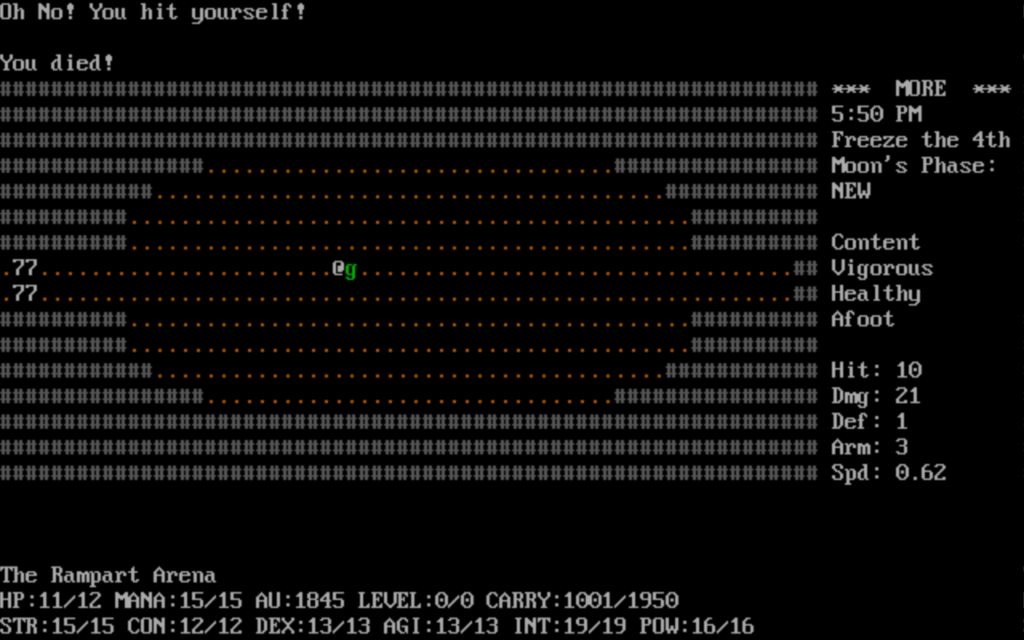
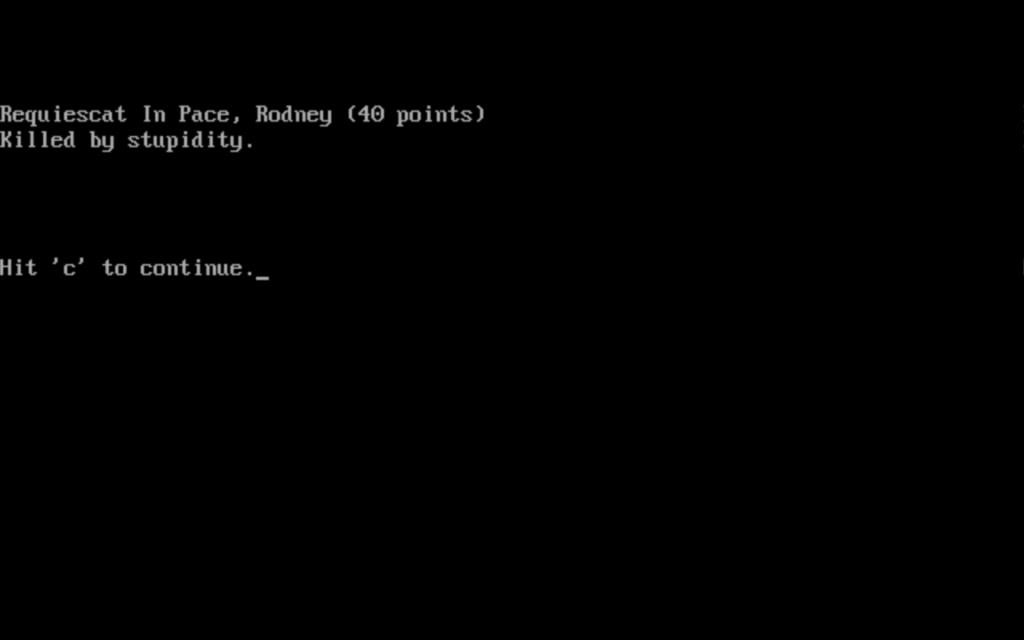
It’s not just death that particularly bad luck can cause.
- Weapons can shatter if you roll particularly badly in a fight. In general, you should consider your equipment in Omega as ultimately temporary.
- Punching is of little use against strong enemies, so I bought a broad sword for 180 gold. Ventured into the wilderness. Got a random encounter involving a freaking lich. I managed to get away, but not before it destroyed my broad sword from a distance with a spell of Destructo Weaponum. I headed back to town and bought another one, then went to the Goblin Caves. Saw some money, stepped to pick it up, but surprise, there was an acid trap there! It destroyed my thieves’ picks, a bucket of Lyzzard Partes, and my broad sword again! Grawlix grawlix.
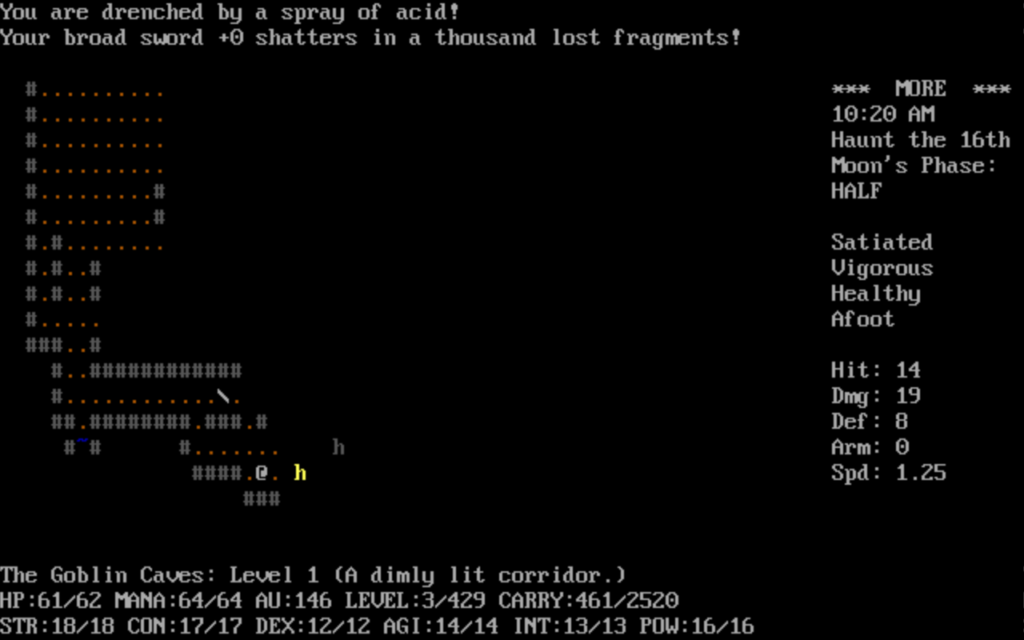
- If an item gets cursed, you don’t have many recourses. I’ve never seen a scroll of blessing work on them; reading the source code suggests they’re just not strong enough. The most practical thing to do is break the weapon to bits with your bare hands: use the ‘z’ key.
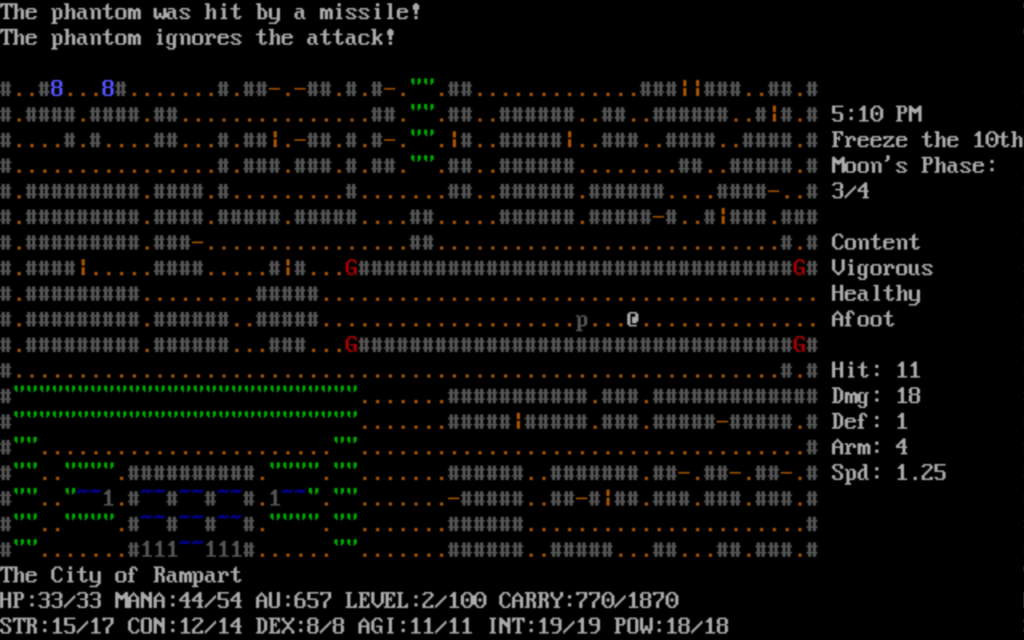
- Phantoms that appear in the hedge maze can level drain you; the main defense against that is a Cloak of Negimmunity, which you probably won’t have at that stage. If you just walk near the hedge maze, it’s possible to awaken a phantom sleeping inside. Phantoms are incorporeal, so weapon attacks don’t work on them, and once they’re awake they can chase you, floating right through buildings, throughout the whole city. The entrance to the city is a long passage with walls on both sides; if you don’t have a way of dealing with the phantom (use magic if you can), it’ll block the passage when you leave town, and get a few free hits on you when you return.
And then there’s the worst death of all, an attack by the dread monster Segmentation Violation:
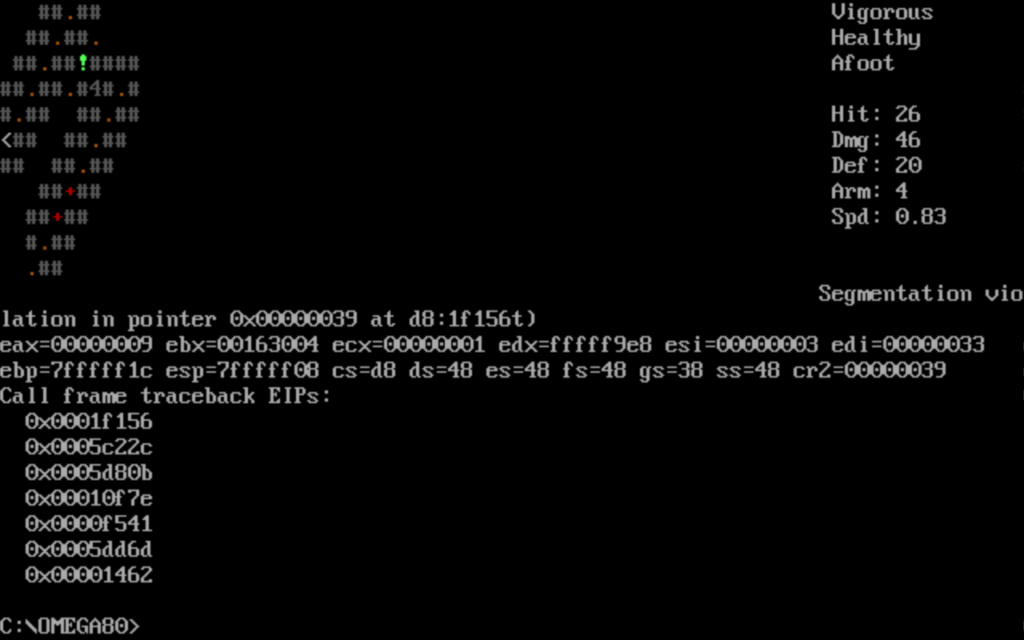
So what is my point? It’s not that you shouldn’t play Omega. It’s that you have to expect that your game could end at almost any time. Your game is not yours to have. Your character lives on borrowed time, so do as much with it as you can while you’ve got them.
These are a few things you can’t completely prevent, but what you can do is reduce their frequency. You can reduce the number of spaces you walk through in dungeons. You can try not to be slow when traveling the wilderness. If you encounter a trap, it might not be fair to it, but riding a horse will mean its effects are more likely to happen to it than to you. And good armor is almost always helpful, if you can afford it.
But sometimes, you just die. That’s just the kind of game it is. As you get better at Omega, you still suffer from them, but as you learn to play more effectively, you do find you get farther much more often.
How best to do that will be the subject of the next, and last for now, column on Omega.

